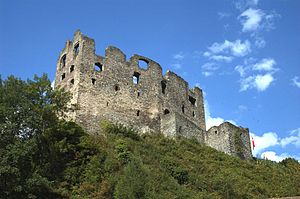Gräpplang Castle
| Gräpplang Castle | ||
|---|---|---|
|
Gräpplang Castle |
||
| Alternative name (s): | Castrum Flumius | |
| Creation time : | around 1100 to 1200 | |
| Castle type : | Höhenburg, spur location | |
| Conservation status: | ruin | |
| Place: | Flums -Gräpplang | |
| Geographical location | 47 ° 6 '10 " N , 9 ° 19' 56" E | |
| Height: | 450 m above sea level M. | |
|
|
||
The castle Gräpplang even Castrum Flumius called, is the ruin of a Spur castle in Flums in the canton of St. Gallen in Switzerland. The name Groppa lunga means long rock . The Romansh origin of the word suggests that this language was widespread in this area.
location
The ruin is 450 m above sea level. M. across the valley of the Seez on a rocky spur that slopes steeply to the north and east above the old trade route from Zurich to the Bündner passes. Several finds from different epochs indicate that Gräpplang was already settled in prehistoric times and in the Bronze Age.
investment
The elongated complex consists of two parts: the main castle in the west and the slightly lower outer bailey in the east, separated by a section ditch . The main castle consists of the keep in the eastern part and the castle courtyard with a cistern in the northeast corner. The farm later became a five-storey palace rebuilt. This was divided several times and had a trapezoidal floor plan. A room with a vaulted ceiling on the upper floor on the east side served as a chapel; Remains of the altar base and the sacristy room are still preserved.
In order to increase the cosiness, many windows have been converted into wide arched windows over the centuries ; however, there are still traces of the old three-pass windows . Remnants of the old lime plaster have been preserved on the facade.
Access to the hall is secured on the south side by a kennel ; this itself could only be reached via a bridge over the moat between the outer and main castle. The current access to the Zwinger and Palas probably dates from the 16th century. In the past, access was via a narrow ledge to below the high entrance , which could only be reached with a ladder.
In the gate to the castle courtyard there are still holes for the crossbars that could be used to lock the entrance. The farm buildings are still visible in the outer bailey. They were attached to the curtain wall that surrounded the hill. The kitchen could also be located.
history
The main castle probably dates from the 12th century; The outer bailey and farm buildings are younger. Gräpplang Castle was built around 1220 by the Knights of Flums, who were appointed by the Bishop of Chur as administrators of the manorial court of Flums. It is first mentioned in 1249: At that time the diocese of Chur awarded the Castrum Flumius to Heinrich von Flums. The name Crepalla appears from the 14th century , the name Gräpplang only gained acceptance around 1500.
From the end of the 13th century the episcopal rule of Flums was pledged several times, for example in 1292 to the knight Ulrich von Flums and from 1419 to 1458 to the city of Zurich as well as to the families Montfort , Stadion , Hertenegg and Schauenstein.
During the Old Zurich War (1436–1450), the castle was extorted from the Glarnern and Schwyzers for protection money in 1440, but was never attacked or destroyed militarily. As early as 1460, Ulrich von Grünenberg was mentioned again as an episcopal Vogt on Gräpplang.
1528 sold Gotteshausbund in the absence of outside the country fled Bishop Paul Ziegler the secluded estate in Flums for 2,400 Rhenish Gulden Ludwig Tschudi of Glarus, the brother of Glarus chroniclers Aegidius Tschudi . Gräpplang Castle remained in the Tschudi family until 1767; twelve members of the family are attested as lords of the castle on Gräpplang.
The Tschudi gave the complex its still recognizable character: around 1700, the complex was structurally changed under Josef Anton Tschudi (1683–1743). The outer wall of the outer bailey was closed, the kennel was relocated and redesigned, the second cistern was built and the access to the inner bailey was lowered.
However, the construction work was of poor quality, so that expensive maintenance work was necessary. In 1767 the Tschudi Gräpplang sold to the Good family , but they hardly seem to have lived in the crumbling castle.
In 1804 the system was sold to Josef Eberli in Flums after it was demolished. In the decades that followed, the stones from Gräpplang were used to repair buildings in the vicinity of the castle and the roof tiles were used to repair the church in Vilters .
It was not until the 20th century that the preservation of the still stately ruin began. From 1914 on, the local tourist office carried out the first repair work and in 1928 the Flums municipality took over the castle.
Between 1990 and 1991, extensive conservation work was last carried out on the castle. In 1998, narrow stairs and walkways were added to the interior of the palace and made accessible to visitors.
gallery
- Gräpplang
literature
- Franziska Knoll-Heitz: Castle research course on Gräpplang near Flums . 33 volumes. Self-published, 1958–90.
- Wolfgang Neubauer: Flums-Gräpplang. A late Bronze Age settlement in Switzerland . Letterpress, Buchs 1994, ISBN 3-908048-24-2 .
- Werner Meyer (Red.): Castles of Switzerland . Volume 6: Cantons of St. Gallen, Thurgau, Appenzell . Silva-Verlag, Zurich 1983.
- Mathias Bugg, David Imper, Wolfgang Neubauer, Fritz Rigendinger, Martin Peter Schindler: Flums-Gräpplang. 4000 years of history . Pro Gräpplang Foundation, Flums 2006, ISBN 3-033-00834-8 .
















